Key takeaways:
- Landscape photography captures the beauty of nature and involves understanding the interaction of light, weather, and composition.
- Effective composition techniques include using leading lines, foreground elements, and symmetry to enhance depth and storytelling.
- The golden hour and blue hour are ideal times for capturing vibrant and ethereal landscape photos, influenced by weather conditions.
- Preparation, patience, and exploration of different perspectives are essential for achieving powerful landscape images.
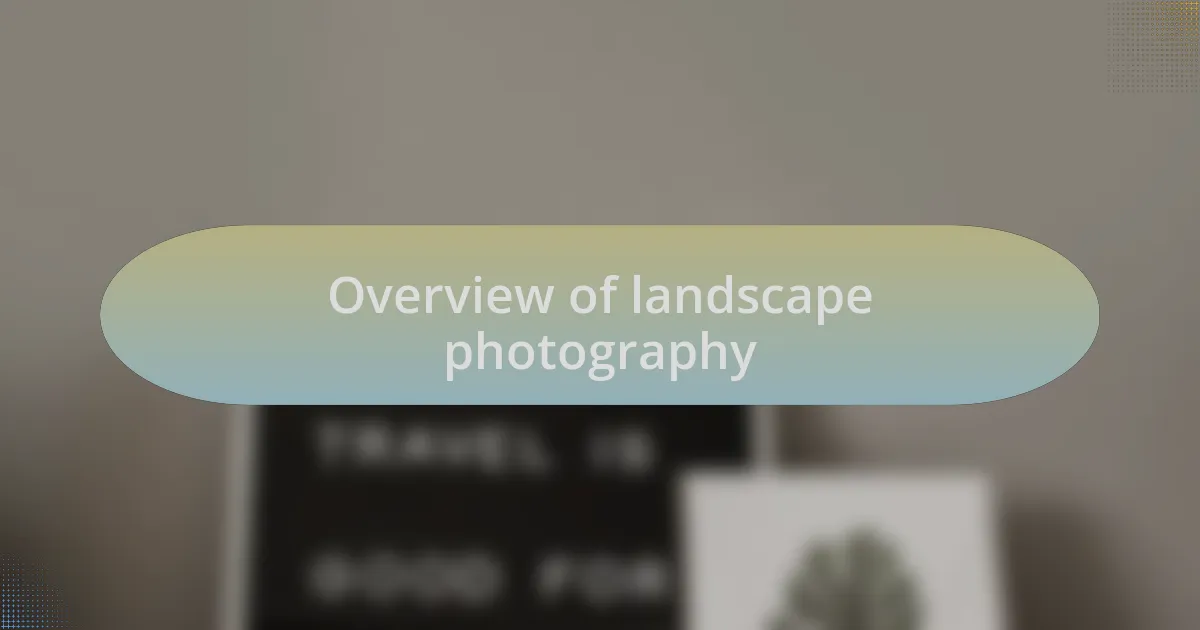
Overview of landscape photography
Landscape photography is all about capturing the beauty of the natural world, from stunning mountain vistas to serene lakesides. I remember my first time standing at the edge of a cliff during sunrise, the light slowly revealing the landscape below. That moment stirred something deep inside me; it’s as if the world itself was inviting me to capture its essence.
When I think about landscape photography, I often consider how the elements of nature interact with each other—light, weather, and topography all play crucial roles. Have you ever stood in a rain shower, feeling droplets dance on your skin, and wondered how that would translate to a photograph? Those moments can shift the ordinary into the extraordinary, adding moodiness and depth to an image that might otherwise feel flat.
Understanding composition is vital in this genre. I find that applying the rule of thirds guides my framing and helps draw the viewer’s eye to the subject. During my travels, I’ve learned that sometimes the most unexpected angles can lead to breathtaking shots. Have you ever explored a well-trodden path and found a hidden gem off the beaten track? Those discoveries remind me that there’s always more to uncover in landscape photography.
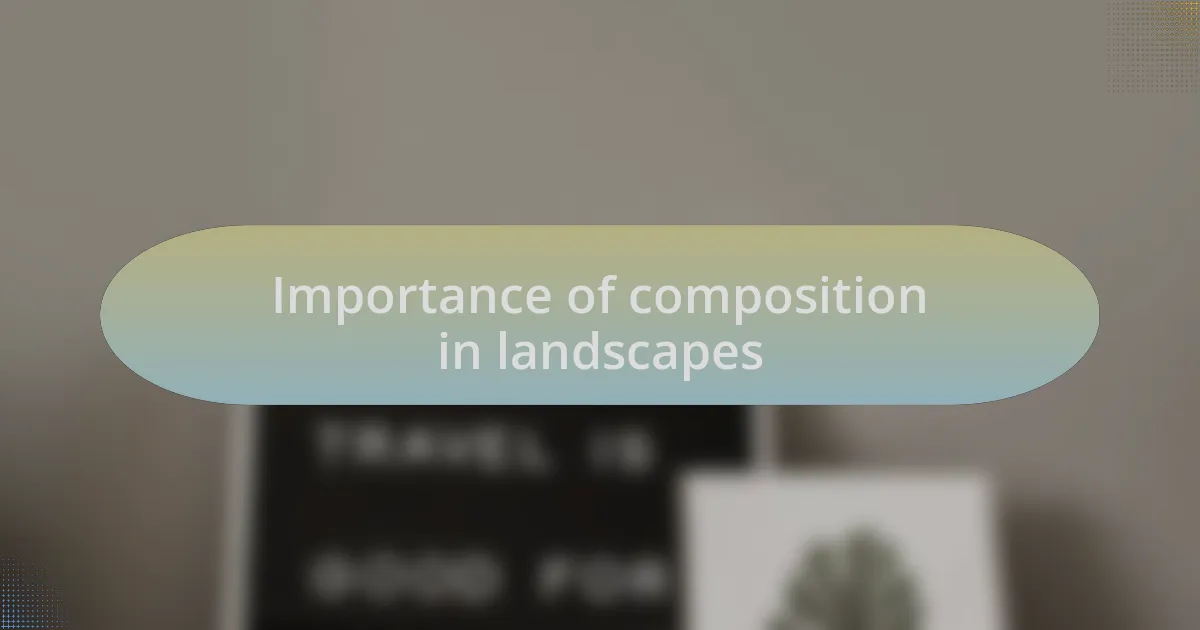
Importance of composition in landscapes
Capturing landscapes is much more than just pointing the camera and clicking; it’s about how you arrange elements within the frame. I once spent hours at a particular spot in a vast meadow, carefully positioning my camera to include the foreground flowers leading up to the majestic mountains in the distance. That sense of depth, created by thoughtful composition, transformed a simple scene into a robust storytelling image that drew people in.
I’ve also discovered that leading lines are incredibly effective in landscapes. For instance, while hiking along a winding river, I positioned myself to capture its curves leading into the horizon. It was like the river itself was guiding my audience’s eyes toward the majestic mountains, and this approach turned a flat image into something immersive and dynamic. Have you noticed how a well-composed photograph can evoke emotions—making viewers feel as if they are walking right into the scene?
Moreover, symmetry can be a powerful tool in landscape photography. I recall a serene lake reflecting a perfectly blue sky, prompting me to frame the shot in a way that emphasized the symmetry of the scene. This balanced composition creates a sense of harmony and peace that can resonate deeply with anyone who views it. Do you think your own experiences with symmetry in photography could enhance the emotions your audience feels when viewing your landscapes?
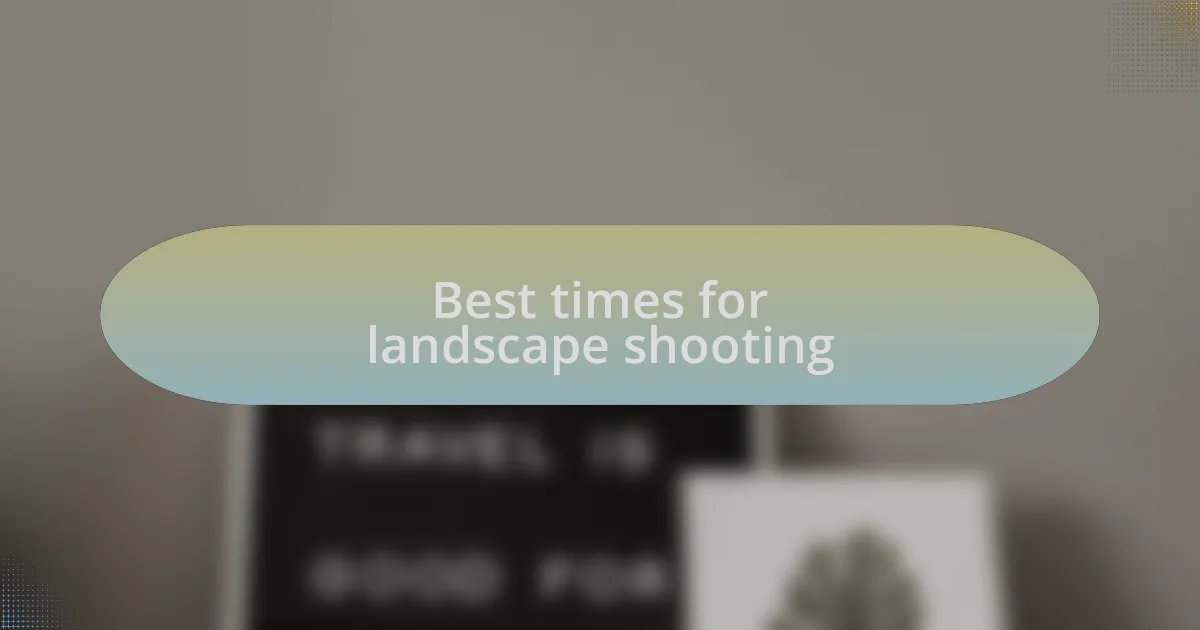
Best times for landscape shooting
The magic hour, often referred to as golden hour, is undeniably the best time for landscape shooting. I vividly remember standing on a cliff at sunrise, with the soft, warm light spilling over the horizon, casting a gentle glow on everything it touched. It was as if the entire landscape was transformed into a painting, rich with color and life. Have you ever experienced that mesmerizing moment when everything aligns just right, and suddenly, your photographs burst with vibrancy?
In addition to the golden hour, I’ve found that blue hour, which occurs just after sunset or before sunrise, offers a wonderfully different vibe. During this time, the cool tones can create an ethereal quality, enhancing the mood of night landscapes. I once captured a serene waterfront scene at twilight, with the lights reflecting on the water, creating a dreamlike effect that felt almost surreal. Isn’t it fascinating how the time of day can completely change the narrative of a photograph?
Weather conditions also play a crucial role in landscape shooting times. I’ll never forget an overcast day when I ventured out despite the gloomy predictions. Surprisingly, the diffused light helped me capture the rich textures of the moss-covered rocks and vibrant greens of the forest without harsh shadows. It reminded me that sometimes the less-than-ideal conditions can lead to the most unique and compelling images. Have you ever ventured out on a seemingly unfavorable day only to find a hidden gem in your photos?

Techniques for capturing depth
To capture depth effectively, employing leading lines is one of my favorite techniques. Whether it’s a winding path or a river that draws the viewer’s eye into the scene, these elements guide attention and create a sense of perspective. I still remember an autumn hike when I stumbled upon a tree-lined road, and as I composed my shot, the lines converged in the distance, making the landscape feel expansive. Isn’t it amazing how such simple elements can elevate a photograph?
Another technique that resonates with me is using foreground elements. I once positioned a cluster of wildflowers in the foreground while capturing a majestic mountain range behind them. This not only added layers to my image but also made the viewer feel as if they were journeying into the scene themselves. Have you tried incorporating something in the foreground to add that immersive touch to your landscapes?
Lastly, I cannot stress enough the importance of atmospheric conditions. Soft fog, for instance, can add a mystical quality and further enhance the depth within a landscape by creating layers. On a chilly morning, when the fog rolled in unexpectedly, I was able to capture a serene scene where the trees appeared like silhouettes, creating a dreamy feel. Don’t you love when nature presents those unexpected opportunities that challenge your perspective?
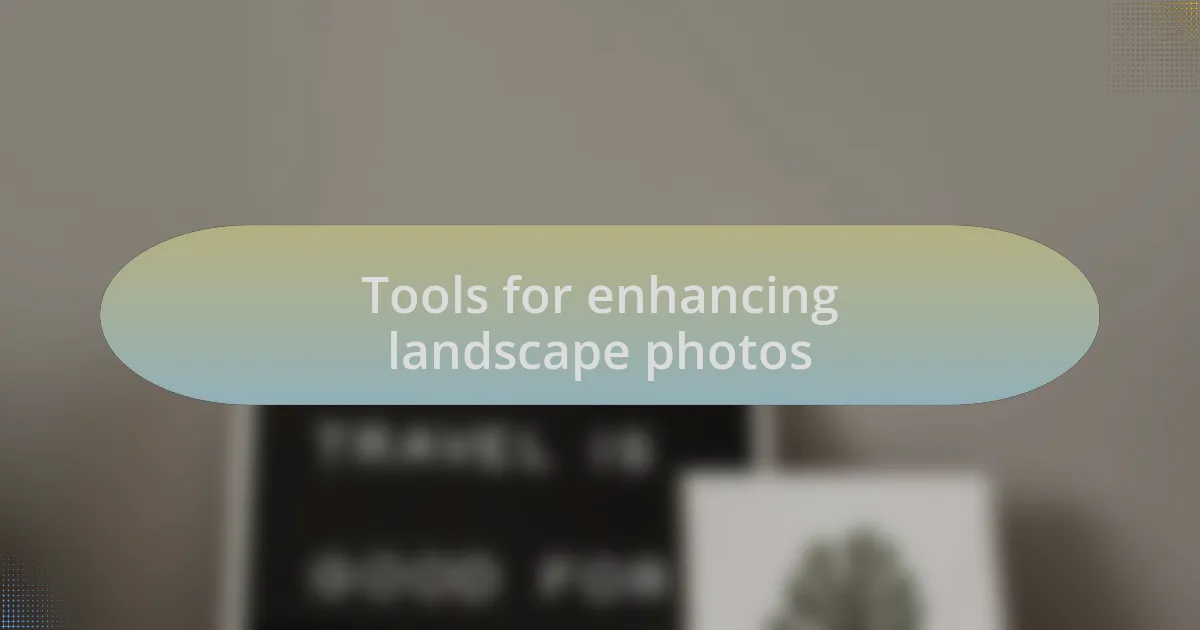
Tools for enhancing landscape photos
When it comes to tools for enhancing landscape photos, I’ve found that using a polarizing filter can make a dramatic difference. This filter reduces glare and enhances colors, particularly in vibrant scenes like a clear blue sky or lush forests. I recall a day spent by a lake, where the reflection of the clouds was almost magical, all thanks to the polarized effect that brought out those rich blues. Have you ever noticed how a simple adjustment can transform an ordinary shot into something breathtaking?
Another essential tool I swear by is a sturdy tripod. It may seem straightforward, but I’ve had countless experiences where a tripod has saved my landscape compositions. During a sunset shoot, the long exposure allowed me to capture the soft movement of water alongside the vivid hues in the sky without introducing camera shake. There’s truly a sense of stability and professionalism it brings to my work. What if you could consistently create those stunning long-exposure shots with just the right support?
Lastly, I can’t overlook the importance of post-processing software. Programs like Lightroom have become my playground for fine-tuning my images. I vividly remember working on a photograph of a sunrise; with a few tweaks to contrast and saturation, the scene transformed into this striking masterpiece. It’s fascinating to see how the right editing tools can enhance your vision and bring your artistic ideas to life. Have you ventured into the world of post-processing, and what changes have you made to your own photos?
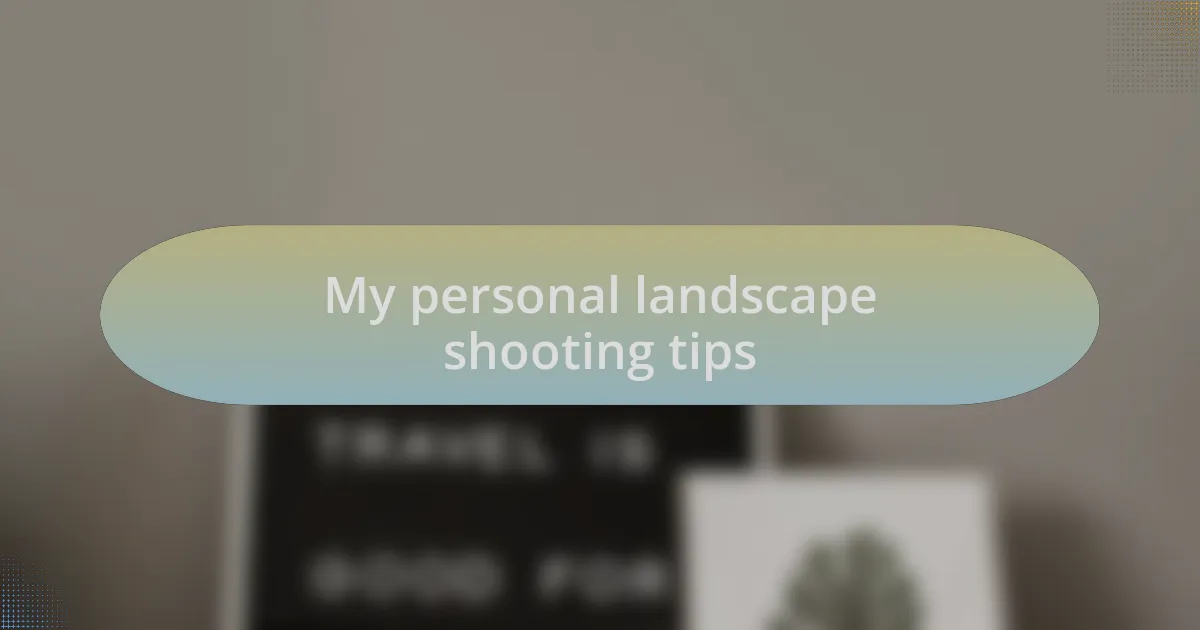
My personal landscape shooting tips
One of my go-to tips for landscape shooting is to always be aware of the light. I’ve had mornings where I set out at dawn, and the golden hour bathed everything in a warm glow. There’s magic in the way the light enhances textures and colors, creating depth in my images. Have you ever captured that perfect moment when the sun breaks through the clouds?
Another personal strategy I use is to find foreground elements to add depth to my compositions. I once spent an afternoon capturing a lake at sunset, and by including some wildflowers in the foreground, I was able to lead the viewer’s eye into the scene. It’s incredible how a small addition can transform a flat image into one that feels three-dimensional. How do you incorporate elements in your frame to create a more engaging photo?
Lastly, patience is key in landscape photography. I fondly recall waiting for nearly an hour at a specific viewpoint, just to catch the perfect moment when the fog rolled over the hills at sunrise. That sense of anticipation can truly pay off, resulting in breathtaking shots that resonate with emotion. Have you ever felt that thrill of waiting for just the right moment to capture your vision?
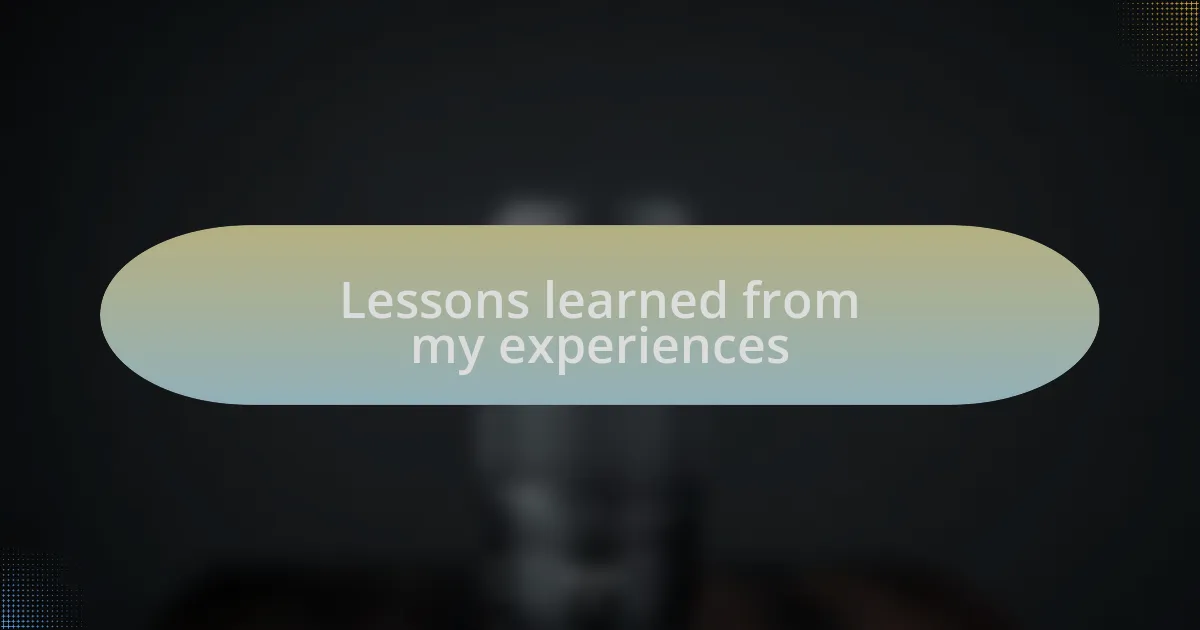
Lessons learned from my experiences
Experiences in the field have taught me that preparation is just as vital as the actual shooting. I remember one chilly morning when I hastily packed my gear and left without checking my battery levels. Arriving at a stunning location, I found my camera dead after just a few shots. That day reinforced how essential it is to double-check everything—especially when you’re chasing fleeting natural light. Have you ever experienced a similar setback that changed your approach?
Another lesson I’ve learned is the importance of exploring unconventional perspectives. I often find myself laying on the ground or climbing to unexpected heights to capture a scene. Last summer, while trekking through a mountainous landscape, I stumbled upon a stunning overlook but realized the best shot was from the edge of a rock face. Stepping outside my comfort zone transformed a typical view into something extraordinary. Can you recall a time when changing your viewpoint significantly altered your composition?
Lastly, engaging with the environment deepens my connection to the scene I’m photographing. I vividly remember a moment by the ocean, where I closed my eyes to feel the salty breeze and the vibrations of crashing waves. That moment influenced my shooting, as I sought to encapsulate not just the visuals but the experience. How often do you let your surroundings guide your photographic decisions? This connection can elevate your work and bring a sense of authenticity to each image.